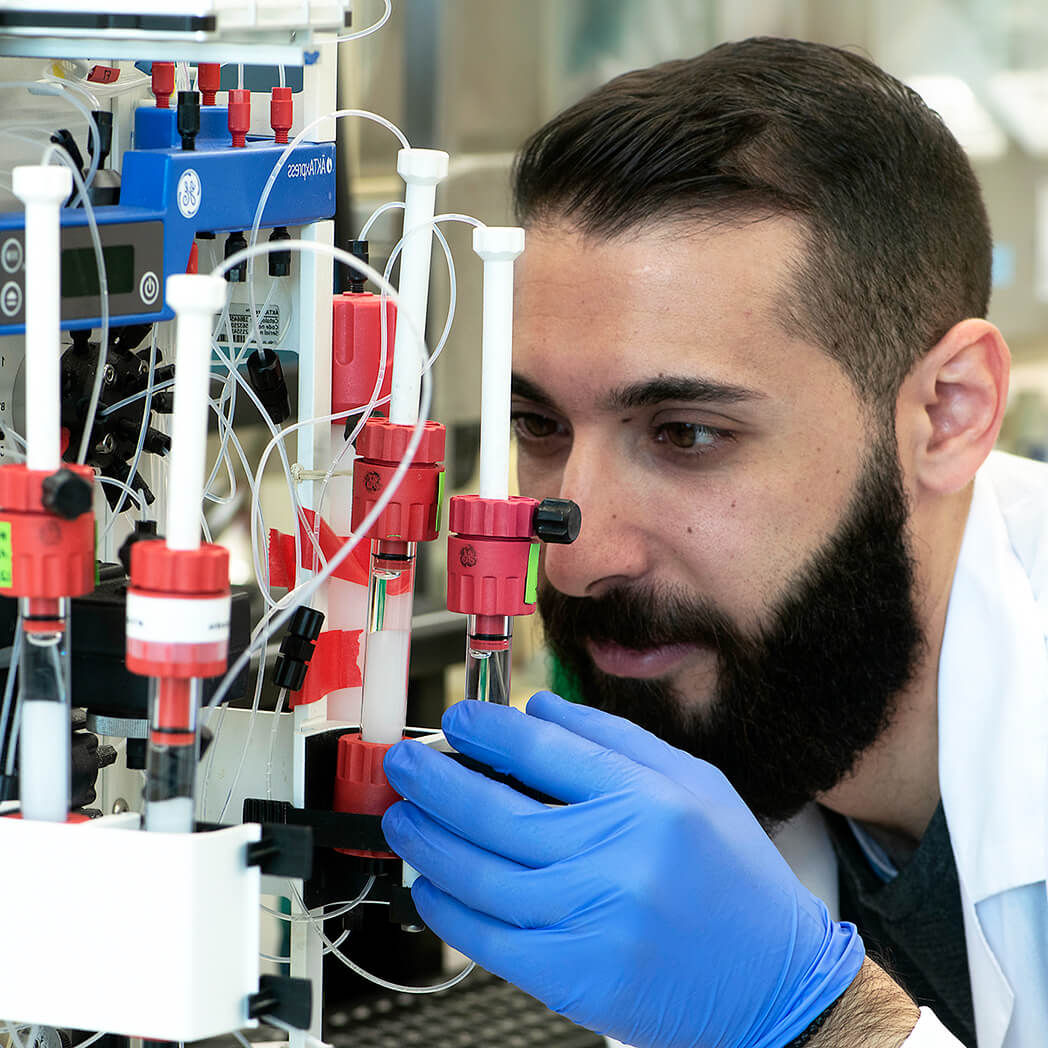Overview
Cat #:
AGR-003
Host: Rabbit
Type: Polyclonal
Form: Lyophilized
Alternative Name Glycine receptor subunit alpha-3, GLRA3, GlyRα3
Accession (Uniprot) Number P24524
Gene ID 114516
Application key:
CBE- Cell-based ELISA, FC- Flow cytometry, ICC- Immunocytochemistry, IE- Indirect ELISA, IF- Immunofluorescence, IFC- Indirect flow cytometry, IHC- Immunohistochemistry, IP- Immunoprecipitation, LCI- Live cell imaging, N- Neutralization, WB- Western blot
Species reactivity key:
H- Human, M- Mouse, R- Rat
For research purposes only, not for human use
Specifications
Properties
Immunogen
- Peptide (C)KNKTEAFALEKFYR, corresponding to amino acid residues 355-368 of rat GlyRα3 (Accession P24524). 2nd intracellular loop.
Homology Mouse, human - identical.
RRID AB_2039889.
Purity Affinity purified on immobilized antigen.
Form Lyophilized powder. Reconstituted antibody contains phosphate buffered saline (PBS), pH 7.4, 1% BSA, 0.05% NaN3.
Form Lyophilized powder. Reconstituted antibody contains phosphate buffered saline (PBS), pH 7.4.
Isotype Rabbit IgG.
Standard quality control of each lot Western blot analysis.
Peptide confirmation Confirmed by amino acid analysis and mass spectrometry.
Storage before reconstitution The antibody ships as a lyophilized powder at room temperature. Upon arrival, it should be stored at -20°C.
Reconstitution 25 µl, 50 µl or 0.2 ml double distilled water (DDW), depending on the sample size.
Reconstitution 0.2 ml double distilled water (DDW).
Antibody concentration after reconstitution 0.8 mg/ml.
Storage after reconstitution The reconstituted solution can be stored at 4°C for up to 1 week. For longer periods, small aliquots should be stored at -20°C. Avoid multiple freezing and thawing. Centrifuge all antibody preparations before use (10000 x g 5 min).
Applications
Applications
Western blot
Immunohistochemistry
- Rat trigeminal ganglion sections (1:100) (Bae, J.Y. et al. (2016) Brain Struct. Funct. 221, 4601.).
 Expression of Glycine Receptor alpha 3 in rat dorsal raphe nucleus (DRN).Immunohistochemical staining of perfusion-fixed frozen rat brain sections with Anti-Glycine Receptor α3 Antibody (#AGR-003), (1:300), followed by goat anti-rabbit-AlexaFluor-488. A. GlyRα3 immunoreactivity (green) appears in DRN neurons (arrows). B. Pre-incubation of the antibody with Glycine Receptor α3 Blocking Peptide (BLP-GR003), suppressed staining. Cell nuclei are stained with DAPI (blue).
Expression of Glycine Receptor alpha 3 in rat dorsal raphe nucleus (DRN).Immunohistochemical staining of perfusion-fixed frozen rat brain sections with Anti-Glycine Receptor α3 Antibody (#AGR-003), (1:300), followed by goat anti-rabbit-AlexaFluor-488. A. GlyRα3 immunoreactivity (green) appears in DRN neurons (arrows). B. Pre-incubation of the antibody with Glycine Receptor α3 Blocking Peptide (BLP-GR003), suppressed staining. Cell nuclei are stained with DAPI (blue). Expression of Glycine Receptor alpha 3 in rat substantia nigra pars compacta (SNC).Immunohistochemical staining of perfusion-fixed frozen rat brain sections with Anti-Glycine Receptor α3 Antibody (#AGR-003), (1:300), followed by goat anti-rabbit-AlexaFluor-488. A. GlyRα3 immunoreactivity (green) appears in outlines of neurons (arrows). B. Pre-incubation of the antibody with Glycine Receptor α3 Blocking Peptide (BLP-GR003), suppressed staining. Cell nuclei are stained with DAPI (blue).
Expression of Glycine Receptor alpha 3 in rat substantia nigra pars compacta (SNC).Immunohistochemical staining of perfusion-fixed frozen rat brain sections with Anti-Glycine Receptor α3 Antibody (#AGR-003), (1:300), followed by goat anti-rabbit-AlexaFluor-488. A. GlyRα3 immunoreactivity (green) appears in outlines of neurons (arrows). B. Pre-incubation of the antibody with Glycine Receptor α3 Blocking Peptide (BLP-GR003), suppressed staining. Cell nuclei are stained with DAPI (blue).
Scientific Background
Scientific Background
Scientific background
Glycine is a major neurotransmitter in the mammalian central nervous system.1 The glycine receptor is a ligand gated Cl- channel, mediating synaptic inhibition in the spinal cord, retina and regions of the brain.2
The glycine receptor is a pentamer consisting of α and β subunits. To date there are four known α-subunit isoforms (α1-α4) encoded by different genes.2-4
In humans, two alternative splice variants of the glycine receptor α3 have been described: α3L and α3K, where the α3L splice variant bears an additional segment of 15 amino acids within the long cytoplasmic TM3-4 loop. These variants differ in their desensitization kinetics.3
Last Update: 25/03/2025

